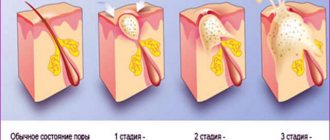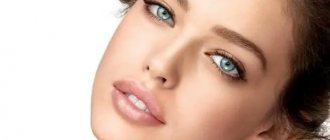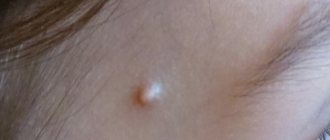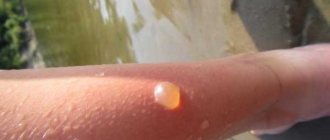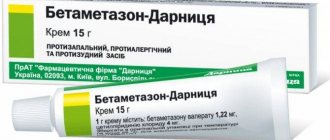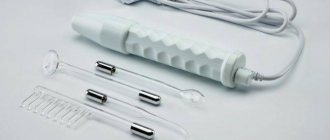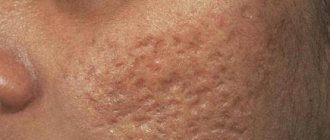The influence of water bodies on human skin health
In summer, you especially want to hide from the heat in cool water, but before swimming in fresh water or a lake, you need to carefully study the safety rules and weigh all the risks. An increase in air temperature causes the proliferation of pathogenic microorganisms in water, which can cause many skin problems and infectious diseases. Swimming in clean water can strengthen the immune system and have a positive effect on the nervous system, so you should not deprive yourself of such pleasure. If there is a lot of vegetation and birds swimming in a lake with clear water, it is still better to refrain from water procedures, because cercariae may be waiting for a person.
The most dangerous zone is considered to be closed reservoirs with stagnant water, contaminated with industrial waste and garbage.
You should immediately contact a doctor in the following cases:
- an increase in temperature immediately after visiting a pond or for several days;
- nausea and vomiting;
- diarrhea;
- red pimples or spots on the body accompanied by itching;
- ear pain;
- redness and inflammation of the eyes.
Of course, you need to swim only in clean ponds, where you are allowed to plunge into the water without risk to health. As a rule, in polluted and dangerous water bodies a special warning sign is placed for humans. To avoid getting infected when swimming in unknown bodies of water, you should follow simple rules:
- do not swim in water with ducks and other waterfowl;
- feed birds only outside the reservoir so that they do not remain in the water and spread helminths;
- lubricate the skin with oil or a special repellent cream;
- do not enter a lake or river with dirty or colored water;
- It is better to choose rubber slippers to protect yourself from cuts and injuries;
- cuts and scratches are a contraindication to swimming in closed waters.
Beaches should be specially equipped for swimming, and it is better to catch fish from a boat rather than going into the water, especially if there are reeds in it. If immersion in water cannot be avoided, you need to protect your skin with special clothing and rubber high boots. It is not recommended to swim in places where there are ducks, as well as other birds that are fed by people. To protect against cercariae, repellents are applied to the body, the effect of which lasts for 1 or 2 hours. Instead of special ointments, you can spread the skin with a Vaseline-based cream.
In reservoirs with a shallow bottom, the water warms up much faster, which promotes the proliferation of pathogenic microorganisms and worm larvae. It is better to choose beaches with fewer people, where the risk of infection is much lower. Bathing rules will help avoid infection:
- You need to stay in the water for no more than 10 minutes.
- Swim in lakes with a depth of at least one meter.
- After swimming, rinse with clean running water.
Video on the topic of what is swimmer's itch - cercariae.
Hello, the problem appeared about 5 years ago, now I’m 33. Red spots similar to a mosquito bite with a slight swelling in the center began to appear after swimming in the sea, river or pool, there is no itching, it goes away in about 10 minutes, it doesn’t interfere with life, but I would like to know what the problem is ? Today we showed up for the first time after I actually started practicing contrast showers. Please tell me, there are a lot of people on the forums with a similar problem, but I haven’t found a clear answer. Thank you in advance.
Brodin Vadim, Krasnodar
QUESTION FOR CLARIFICATION 09/08/2014 Melnik Anna, Tikhvin
Hello, after drinking water, red spots appear on my body, similar to mosquito bites, they itch, and go away in about half an hour. Sometimes they just pop up even on the face. What could this be?
ANSWERED: 09/08/2014
Vadim, good afternoon! Diagnosis of your disease: Chronic urticaria. Very . There are many reasons for its occurrence. To understand the problem, it takes time and the desire of a doctor. The question arises, did you contact a specialist and did you undergo any treatment? First of all, it is necessary to undergo an examination: blood for Giardia, opisthorchia, Toxocara, Helicobacter. Any positive result requires consultation and treatment with an infectious disease specialist or gastroenterologist. If rashes occur, it is necessary to treat with a hypoallergenic diet. There is no point in having an allergy test done by an allergist.
Clarification question
Related questions:
| date | Question | Status |
| 26.10.2015 | I have been suffering from itching in the form of hives for about 3 years. Redness begins, then itching of the whole body, especially the arms, legs and back. After scratching, the area swells for a while, but then I wipe it with water or a vinegar cloth to reduce the redness and it stops for a while. Over the years, no matter what I have done, at the moment I take loratadine 2 times a week when I have no patience at all, it calms me down. I took all the tests I could and was diagnosed with “demographic urticaria.” And treat... | |
| 19.09.2017 | Hello, these spots appeared on my body, the itching was severe after a shower. They turn red after contact with water. The spots are dry. How to treat? Maybe some tests need to be taken? I applied Dermovate ointment and a simple topical cream, but there was no result. Every day they become more and more. | |
| 28.05.2016 | Hello! About 2 weeks ago I noticed a red spot (with a radius of about half a centimeter) on the body of the penis. During sex, it became bright red and was painful to touch. At this time, I began to constantly rinse my penis generously with water 2-3 times and wash it with Clear anti-dandruff shampoo. Sometimes it happened that I was walking in clothes, and then I took my penis out in the toilet and saw that the skin seemed to be peeling off. I wash off this whitish skin and again see a red spot that hurts when pressed. I hope you can... | |
| 24.02.2017 | Hello, I have the same problem! Last year, in the same spring, a red spot appeared on me and immediately went away in a couple of days! This year at the same time and in the same place it came out again, only the consequences were much worse! Red spots appeared all over the body; blisters appeared on one of these spots! A blister filled with some kind of water also came out on my lip, and the same on the head of my penis! Please advise what to do, the hospital is closed because of the holidays | |
| 19.09.2012 | Hello, please tell me, I celebrated a friend’s birthday outdoors and after a while I became covered in red spots all over my body, ate meat, salads and drank whiskey, in my opinion it was of poor quality. The next day, I bought the medicine Zyrtec, it seemed to help, the spots disappeared from the body, only the legs and arms remained, and then less than the first time, I woke up this morning everything appeared again And there’s already a little bit on my face, I’m going to go to the pharmacy and buy also suprastin and calcium glucanate. what's the matter? What about... |
It always manifests itself not as a separate symptom, but in the form of a disease, sometimes serious. What can cause a rash on the body? Causative agents may include infection, allergic reaction and blood disease. In addition to the skin, rashes can also appear on the mucous membranes. Our skin always reacts to the state of our internal organs. And such a reaction may be a manifestation of a rash. First, you should determine the exact cause of the disease, and only then begin a course of treatment.
The rash can be primary or secondary. The first occurs on skin that is not subject to various changes. In this case, symptoms may be: spot, blister, blister, lump, pustule. Then, against the background of the first elements of the rash, a secondary rash appears. In this case, there is an increase or decrease in skin pigmentation, peeling, erosion, cracks and scars appear and other changes in the skin.
The rashes often itch. By scratching them, you injure the skin and as a result, scratches appear, which, when infected, turn into pustules.
The rash on the body can have a different character. The watery, white, red and pink rash occurs in the form of spots, blisters, nodules, roseola and pustules. When diagnosing it, in addition to appearance, additional signs and symptoms of the disease should be taken into account.
If the rash on the body itches and there are no other symptoms, then you should consult a dermatologist.
Causes of the rash
A rash on the body can be the result of certain infectious diseases - for example, herpes infection, chicken pox and other infections. Many blisters appear on the skin, which then dry out and become crusty. Then the crust disappears and a spot remains at the site of the rash, which soon also disappears. If the blisters are scratched, then as a result of infection, ulcers appear instead of a crust, and after them unsightly scars remain.
Allergic manifestations of a rash often mean urticaria. Red raised spots of various shapes appear on the skin. They are often accompanied by itching. With allergies, the same symptoms appear on the internal organs. Therefore, first of all, it is necessary to find out the cause of the disease, and then consult an allergist for a course of treatment.
Specific red rashes along with scarlet fever are symptoms of scarlet fever infection. This body rash is itchy, small and appears in the lower abdomen, groin and buttocks. Sometimes found on the face on the cheeks. In such patients, the symptoms are as follows: the nose and skin around the mouth are pale, bright red cheeks. After a few days, the rash becomes itchy and flaky.
A herpetic infection can cause a rash. In this case, the blisters in the form of hyperemic spots on the body contain clear liquid and itch. Then the bubbles dry out, become crusty, or break open, forming erosion. This herpetic infection appears on the skin of the hands and buttocks. With the disease, headaches, malaise, tingling and itching are common.
It is not uncommon for a rash to appear after the sea and sun. Often these rashes are called solar dermatitis. Redness and swelling appear on the skin, similar to hives. rashes that arise after the sea and sun can become chronic and develop into eczema.
How to avoid getting a rash
You should not try to treat the rash yourself. It is necessary to establish the source of the disease. Once the cause is eliminated, the skin manifestations will gradually disappear. For most people, rashes can occur as a result of allergies to food and medications. If you have a rash on your body, you first need to analyze your diet over the past 36 hours. Allergies can also occur if you consume canned foods, spices and drinks containing dyes. The most allergenic foods are chocolate, citrus fruits and honey. The rashes that appear after these products are always accompanied by itching.
An effective means of preventing rashes and the first method of treatment is to control your diet with a hypoallergenic diet. Because the rashes go away only if the allergen does not enter the body in the future, then if this diet is not followed, the allergy begins to manifest itself in a more pronounced form.
If the rash does not go away on its own, you can use the following remedies to relieve itching and other symptoms:
- ointment and cream based on menthol, pramoxine, camphor or diphenhydramine
- moisturizing lotions
- antihistamines such as loratadine or chlorpheniramine
If these medications do not provide any effect and the symptoms of the rash become more extensive, then you should consult a doctor.
Reaction to the sun
Ultraviolet radiation can cause hypersensitivity in humans. Such processes are accompanied by rashes in the form of papules, vesicles, accompanied by the separation of serous exudate, thickening, roughness of the skin, pigmentation disturbances, and the appearance of grooves are observed.
In healthy people, as a rule, this is rare, mainly occurring in:
- infants;
- children with weakened immune systems;
- people with too light skin (Celtic type);
- old people;
- persons with pathologies of the liver, kidneys, as well as endocrine and immune systems.
There may be other types of immunopathological reactions, phototraumatic and phototoxic. In the first case, it is sunburn. Probably everyone is familiar with how hot and sore the skin is after spending an excessive amount of time on the beach.
Phototoxic burn also occurs as a result of exposure to sunlight. However, here the cause is drugs, foods or other substances that enter the body and produce a photosensitizing effect.
More often, people whose skin is too white or pale are susceptible to allergies. Traumatic effects occur very often.
In addition, photosensitizing substances (PS) often aggravate the situation even in people with normal skin type that is resistant to ultraviolet rays.
Many drugs contain VW in their composition, for example:
- group of tetracyclines (antibiotics);
- neuroleptics;
- sulfonamides;
- antifungals, for example, griseofulfin and some others;
- ethacridine lactate;
- oral contraceptives;
- tar.
Since the main purpose of these drugs is different, their photosensitizing effect is considered as a side effect. Another cause of photodermatosis can be contact with the skin of the juice of plants containing PV.
READ ALSO: Reasons for the appearance of pimples on the body, what diseases may be hidden under these symptoms
Sunburn may occur after direct contact with them. These plants include angelica officinalis, angelica silica and several species of hogweed.
Features of rash during pregnancy
Dermatosis of pregnancy is common in primigravidas. It usually appears as a rash on the chest, back or face. The cause of body rash in pregnant women is hormonal imbalance. Pregnancy rashes are often common in the third trimester. A rash appears on stretch marks, gradually turning into red nodules measuring 2 mm. Often, dermatosis of pregnant women goes away in the first week after birth and does not affect the course of pregnancy in any way. The skin after childbirth is restored to normal.
If the rash causes you severe discomfort, then special medications that are approved for pregnant women will help. If the rash on a pregnant woman’s body is caused by hives and itches, then this itching can be treated with antihistamines.
Rashes in pregnant women caused by infections and viruses are often prerequisites for congenital malformations of the fetus, chromosomal abnormalities and even fetal death.
During pregnancy, a rash can be a reaction to various substances - food, medications, and others. In this case, it appears in the form of bubbles with a clear liquid. Rashes can appear both locally and throughout the body. Allergies may occur for the first time in pregnant women. This is due to medications taken during pregnancy.
A rash in pregnant women can occur due to hormonal changes in the body, as a result of allergies, infectious diseases, herpes, scabies and smallpox. A timely visit to the doctor will save the life of your fetus.
It can be varied, but what to do if strange pimples appear after swimming in a river or local lake. For psychological concerns, it is best to go to the nearest clinic and get examined by a dermatologist. The specialist will prescribe special tests or immediately write a prescription for taking medications and applying ointment to areas of irritation.
How to tan properly
The color of our skin, hair and eyes is determined by a special substance – melanin. For example, among Europeans its presence in the epidermis is insignificant, while among representatives of the Negroid race the skin is maximally saturated with it. Under the influence of ultraviolet rays, this natural pigment concentrates around cell nuclei, thereby protecting the genetic information contained in them. The higher the amount of melanin in the body, the darker the skin color. This is why people with fair skin types are not recommended to spend long periods of time in the open rays of the sun.
Having decided on your genotype, get some means to protect against ultraviolet radiation - high-quality lotions and creams without a strong odor will do (fragrances and chemical components can cause acne). For people with dark skin types, products with a protection level of 30 will be sufficient, while for light-skinned people this indicator should be at least 50. Having stocked up on protective equipment, you can go to the beach. In order to get a beautiful bronze tan, sunbathe according to the rules.
- You should not expose your skin to increased solar radiation. The luminary was most active between 11.00 and 15.00. At this time, it is better to follow the traditions of hot Mediterranean countries and dedicate it to a siesta. Morning and evening hours are optimal for tanning.
- To prevent acne from appearing after sunbathing, treat your skin with an anti-UV preparation, using the recommendations for choosing a cream.
- When you arrive at the beach, do not rush to immediately lie down on the trestle bed - let your body acclimatize. 15 minutes is enough for this. During this time, take a walk at the edge of the surf and ask what entertainment your resort offers.
- Lie down with your feet facing the sun - this way its rays will be more evenly distributed throughout your body.
- The first sunbathing should not exceed 15 minutes, and for people with fair skin - ten. After this, move into the shade.
- Each subsequent day you can increase the duration of exposure to the sun by 2-3 minutes. In the hot sunny season, you can easily get heatstroke or severe burns.
- After tanning, naturally, take a shower and apply a light nourishing tonic cream to your skin. The sun and sea water somewhat dry out the skin, thereby causing the sebaceous glands to work more actively. This can lead to inflammation due to blockage. Using cream after sunbathing will prevent further appearance of pimples.
Prolonged exposure to direct sunlight can not only cause painful burns, but also cause skin cancer. At the same time, moderate stay on the beach promotes the production of vitamin D in the body, which is often called anti-rickets. Tanning in small doses allows the epidermis to renew cells faster.
Treatment of acne on the stomach
Dermatologist, cosmetologist
If the acne that appears after swimming has large ulcers, treatment may not be possible without taking antibiotics, so you should be prepared for this. This is necessary in order to rid the body of the infection that has entered the skin and blood as quickly and effectively as possible. If rashes were noticed immediately after swimming, this could be an infection through an existing infection in the water. In some cases, if appropriate treatment is not carried out, chronic forms of diseases can develop, including death.
Pimples on the abdomen may also appear after swimming in the sea if jellyfish are present in the water. Sea animals sting people unnoticed, and the pimples are quite noticeable immediately after coming ashore. The nature of these pimples usually involves blisters in the form of burns, but unlike blisters caused by fire or steam, they go away quite quickly. They itch and burn at the bite sites, this is due to the poison used by jellyfish on their tentacles, so you should be careful in the water, especially where there are large jellyfish, and it is advisable not to let children into such water.
You can get rid of blisters caused by jellyfish with an anti-inflammatory cream; the blisters may not go away so quickly, but the cream will relieve the itching and burning.
Why does the sun cause acne?
In order to choose the right treatment method, it is important to determine the cause of the rash.
The problem can be individual, but there are the most common situations:
Acne on the body from the sun most often occurs due to the fact that the high ambient temperature causes the sebaceous glands to work in increased mode. If we add to this the dirt contained in the air, then the appearance of rashes is quite understandable;- When the skin is exposed to ultraviolet rays during tanning, existing pimples begin to ripen faster than usual, which increases the size and extent of the rash;
- A rash on the face in summer most often occurs due to the use of decorative cosmetics, since many girls apply makeup even while going to the beach. As you know, such products cause blockage of pores;
- If you stay under the scorching sun for a long time, spots and a small watery rash appear on the skin, and the pimples itch and cause severe discomfort;
- Some medications, for example, a number of antibiotics, diuretics and antihistamines, increase sensitivity to the sun, and, consequently, the risk of acne on the body. Various flavors and fragrances found in cosmetics are also dangerous. Sandalwood, bergamot, cedar and lemon oils have been proven to increase photosensitivity.
It is also worth noting that the number of people who suffer from sun allergies is increasing every year. In the presence of such a disease, the body becomes covered with pimples that itch and turn red. In addition, such a reaction often occurs to various sunscreens.
What can cause acne after swimming in the lake?
Pimples after swimming in the lake can be caused by small, almost invisible mites present in the lake that live on waterfowl, and they can make bites that cause group redness on the human body. To treat them, it is enough to take antihistamines. My patients took advantage of the doctor’s advice, thanks to which they can get rid of problems in 2 weeks without much effort.
Water is a breeding ground for many harmful infections and bacteria, so after swimming in the lake you can expect anything. Small rashes may indicate an allergic reaction. If they do not go away, but rather multiply, their growth can even affect the internal organs, starting with the mucous membrane.
If it is not possible to visit a doctor, you can take the first steps to reduce the itching or spread of acne. If it is not possible to visit a doctor, you can take the first steps to reduce itching or the spread of acne: take a shower or bath using a decoction of soothing herbs - chamomile, calendula, etc., but before that, be sure to wash yourself generously with soap, being careful not to scratch the redness.
The rash may not even be related to swimming in the lake, but simply be a coincidence. Often, acne on the stomach appears during childhood diseases, such as rubella, measles, etc., and swimming in the lake accelerated the process of the disease, since water is an effective factor for the proliferation of bacteria and microbes.
Such signs are quickly identified by the doctor, and home treatment is prescribed with a certain incubation period.
If a childhood disease affects an adult and the symptoms, in addition to a rash, include high fever and general malaise, the patient may be sent for inpatient treatment to a hospital to prevent adverse reactions of the disease.
Any irritation that begins to bother you not only with itching, but also with its appearance, should be monitored by medical professionals to prevent the spread of the disease in the event of an epidemic.
Do not swim in bodies of water where it is prohibited or where waterfowl live. This is one of the recommendations that a dermatologist gave after examining a Chelyabinsk woman with a rash that she and eight of her friends developed after swimming in Lake Turgoyak. Meanwhile, another resident of Chelyabinsk contacted 74.ru with a similar problem. At the same time, Alexander Morozov claims that this disease is very selective.
Let us remind you that a group of nine Chelyabinsk athletes who swam in Turgoyak on July 29 developed a profuse rash all over their bodies. One of the patients, Chelyabinsk resident Yulia, sought advice from the Chelyabinsk Road Clinical Hospital.
“On July 31, a patient came to see me with complaints of rashes all over the skin, which were accompanied by itching,” Yulia Ruchkina, a dermatologist at the medical institution, confirmed to 74.ru. – The patient noted a clear relationship between the appearance of rashes and swimming in Lake Turgoyak. According to the patient, there were nine other athletes with her who trained with her. On July 29, everyone swam in the lake, and on July 30, they all developed identical rashes and itching.
According to the specialist, the patient had 1–3 mm rashes on her skin with a circle of rounded hyperemia (round redness on the skin with bulges). Body temperature did not increase. The general condition was normal.
Regardless of the cause of the skin lesion, the principles of treatment are similar: eliminating itching and relieving inflammation, the dermatologist noted.
“It is necessary to exclude swimming in reservoirs where swimming is prohibited or where waterfowl live, and, if possible, monitor information in the media about the condition of reservoirs in the region,” Yulia Ruchkina pointed out. – The formulation of the diagnosis “contact allergic phytophotodermatitis” indicates that there is an allergic inflammation on the skin caused by possible exposure to allergens of natural, that is, plant origin and enhanced by exposure to ultraviolet radiation - exposure to the sun.
The Miass administration claims that in two weeks they received only one complaint about the quality of the water and the appearance of a rash after swimming in Lake Turgoyak. Meanwhile, another victim of swimming in this lake contacted the editorial office of 74.ru.
“I regularly live from Friday to Monday all year round for several years at a dacha near Turgoyak,” said Alexander Morozov. – The dacha is located on Tourists Street - the only street that runs along the shore of the lake. I am a swimmer, I swim a kilometer or two every day. The first time I developed such a rash after swimming in Turgoyak was in August last year. I also went to our Chelyabinsk dermatovenerology clinic. There they examined me and passed a bunch of tests, about eight thousand, ranging from everything related to allergic reactions to the traditional ones for AIDS, syphilis and hepatitis. But I was never diagnosed. They said it looked like a cold allergy.
– This year I swam in Turgoyak in June. I thought maybe everything had gone away, but no, the rash was back,” continues Alexander Morozov. “I stopped swimming there and swam in Lake Inyshko all summer. But literally this Monday, July 31, I was too lazy and had no time to go to Inyshko. Let me go for a swim in Turgoyak, I think. And again the rash! When it appears, I take antihistamines to stop itching too much, and by the end of the week it goes away. Then I went to other dermatologists, and they said that the only option for me was not to swim in this lake. And this despite the fact that the water in Turgoyak is perfectly clean...
The swimmer himself noted in the conversation that he was not surprised by the statements of many South Urals residents that they did not break out in a rash after swimming in Turgoyak.
“The rash is actually kind of selective,” says Alexander Morozov. – I don’t need to look far for examples: my friend swims – everything is fine with him. At the same time, I have never complained about my immunity; for example, the last time I caught a cold was about 20 years ago. In general, this is some kind of garbage that affects some skin, but not others. I really want Rospotrebnadzor to find out what the problem is.
In the meantime, Rospotrebnadzor has already taken additional samples for analysis and is waiting for research results.
Let us remind you that after swimming in Lake Turgoyak on July 21, residents of the South Urals complained about a rash on social networks. The victims contacted an ambulance, where they were told that there were no orders to close the beaches on the lake, but they could not respond to calls from victims from the lake.
Subsequently, complaints began to be received at other lakes in the Chelyabinsk region. So, a child developed a rash after swimming in Lake Kaldy.
If you develop a rash after swimming in any lake or witness any incident, please send messages, photos and videos to
Until the mid-20th century, cases of the disease were reported exclusively in countries with tropical climates. Today, cases of infection with schistosomatid dermatitis in fresh waters are known.
How to cure acne after sunbathing?
Considering that the causes of the rash are different, it is best to consult a cosmetologist or dermatologist to exclude the development of more serious complications.
There are several ways to treat acne caused by the sun:
- If a rash appears after using protective products, then simply stop using them. If everything goes away, then such cosmetics are simply not suitable;
- When the cause is photodermatitis, it is important to protect the skin from the sun for some time, using various products and closed clothing. Treat damaged areas on the chest, shoulders, face and other parts of the body with Diphenhydramine solution. It is recommended to consult a doctor, since in case of complications, a course of special medications is important;
- If after a trip to the sea you develop rashes after sunbathing, then this may be due to dehydration of the skin, so ensure hydration. Please note that even oily skin needs nutrition and hydration. Give preference to creams with a light texture, as they do not expand or clog pores. It is equally important to use cleansers that do not contain alcohol. Another important point is to maintain hydration by drinking enough water;
- If the desire to get a beautiful tan has led to a burn, then use Panthenol or Lioxazine in the form of a gel topically. To relieve itching, it is allowed to take antihistamines;
- You can treat rashes after sunbathing using cocoa butter, which is used to wipe the affected areas.
To prevent tanning from causing rashes and other skin problems, it is recommended to use masks. Such folk remedies help restore the barrier function of the skin, regenerate cells, and improve the production of collagen and elastane. First, you should test the mask on any area of tanned skin. They need to be done 2-3 hours after sunbathing. The procedure cannot be performed more than 2 times every 7 days.
Effective after-sun masks:
- Cottage cheese. Take 2 teaspoons of full-fat cottage cheese and add 1 teaspoon each of fish oil, strong tea and lemon pulp;
- Cucumber. Grind the cucumber on a fine grater and mix with kefir in different proportions;
- Lemon. Peel the cucumber, grate the pulp and add 10 drops of lemon juice.
Swimmer's itch: causes and course of pathology
It is known that the development of the disease occurs in 3 stages:
Other main symptoms besides those described above include: high fever, dry cough, insomnia and even dizziness. It is important to understand that you should not scratch such rashes, as this can lead to more serious problems with the body.
Physical damage to the skin appears at the site of the lesion, and decomposition causes toxic dermatitis of the allergic type. Open wounds become gateways for infection. In addition, there have been cases of larvae getting under the skin when walking barefoot in shallow water, on grass wet with dew near the shore of a reservoir.
Swimmer's itch: treatment
Today there are several proven medications that are used to relieve itching and inflammatory symptoms. On average, itching after swimming in a lake or other body of water goes away after 2 weeks and does not require any specific treatment. However, when the discomfort is unbearable, you can use some medications that will reduce the occurrence of unpleasant symptoms.
- Diphenhydramine based 5%. Has anti-edematous, antipruritic and anti-allergic effects. The peculiarity is that such a composition cannot simply be purchased at a pharmacy, it must be ordered, and this can only be done with a doctor’s prescription;
- Menthol. This drug has a wide range of activities. After application, you feel a feeling of coolness and a slight tingling sensation. This occurs due to the direct effect of the active substance on the nerve endings;
- Anesthetic. Has a local anesthetic effect. Reduces the permeability of cell membranes, which in turn blocks the conduction of nerve impulses. All this leads to a reduction in itching after swimming in a lake or river. Contraindications: individual intolerance, pregnancy and lactation, as well as age under 1 year.
In more advanced conditions, oral medications help, namely:
- Diphenhydramine. Has a wide range of positive effects. Reduces smooth muscle spasms that occur due to itching and swelling, and also increases capillary permeability. Contraindications: intolerance, attack of bronchial asthma, lactation period and age under 6 years;
- Bicarfena. An effective remedy for combating allergic diseases that are accompanied by itching. Contraindications: hypersensitivity, disorders of the kidneys and liver, pregnancy and breastfeeding;
- Tavegila. Indications for use include not only insect bites, but also other unpleasant situations that lead to an allergic reaction. Contraindications: bronchial asthma, pregnancy and lactation, intolerance and age under 6 years;
- Suprastina. An antiallergic agent that significantly facilitates the course of allergic diseases. Contraindications: intolerance, asthma, pregnancy and lactation, age under 5 years.
The dosage is prescribed only by the attending physician. It differs depending on the severity of the disease and the general condition of the patient. To lower the temperature, conventional antipyretic drugs are used. Sleeping pills are prescribed for insomnia.
When choosing recipes from traditional medicine, it is recommended to pay attention to the following remedies:
- To relieve itching after swimming in the lake and other inflammatory manifestations, use various cooling lotions based on cold water or soda solution;
- Good results are shown by herbal mixtures from celandine or string, which are used to wipe the affected areas;
- You can apply a paste of baking soda to the affected areas.
Preventing swimmer's itch
In order not to look for a way out of the situation when your body itches after swimming, you need to carefully choose a body of water for swimming. It is recommended that you avoid diving in water with creatures such as waterfowl and shellfish.
People who decide to spend their free time near a lake or river and swim in them may be in for unpleasant surprises, for which they need to be prepared. High temperatures and other factors contribute to the proliferation of pathogenic microorganisms in water bodies, leading to skin diseases. Sometimes after swimming, acne appears on the body and you need to know how to deal with it.
Beaches are often closed for swimming in hot weather in the summer, but many people ignore the established safety measures and end up with an unpleasant skin rash. A severe allergic reaction, spots and pimples on the body are not the only consequences of careless bathing.
How to get rid of acne and pimples
Methods of dealing with rashes that have already appeared also depend on the cause of their appearance. It is not recommended to treat formations on your own; you should consult a dermatologist, who, depending on the individual characteristics of the body and the cause, will prescribe therapy.
If the cause of acne is an allergy, your doctor will most likely recommend an antihistamine. In other cases it could be:
- antiseptic and anti-inflammatory creams and ointments;
- wound healing agents;
- anti-acne medications;
- compositions with drying properties;
- drugs for the treatment of a specific dermatological disease.
A dermatologist will help you choose the right products to treat acne after sunbathing.
In addition to taking medications prescribed by your doctor, you must:
- balance the diet (exclude salty, spicy, fried, fatty foods, flour and sweets);
- observe the rules of personal hygiene (regularly shower and wash using mild cleansers).
During treatment, you should not be in direct sunlight or use cosmetics that could cause rashes.
Video: doctor about the treatment of photodermatitis
Folk remedies
Folk remedies will help soothe the skin, relieve inflammation and reduce itching, but they can only be used as auxiliary methods in combination with the therapy prescribed by a doctor and only after consultation with a dermatologist.
Supporters of unconventional methods recommend:
- Herbal decoctions. Pour 2 tablespoons of raw material into a liter of boiling water and leave in a steam bath for 10 minutes. Cool, strain. To prepare decoctions, you can use string, chamomile, celandine, calendula or sage. Use for lotions and wipes.
- Washing with tar or laundry soap. If your skin is dry and/or overly sensitive, this should not be done.
- Aloe juice. Used for daily wiping of affected areas.
Calendula decoction will soothe irritated skin
A cool shower will help relieve burning and itching.
Causes of acne after swimming
One of the most common causes of rashes on the body after swimming is birds and the cercariae they leave in the water. If a body of water is infected with bird helminths, a person will develop red spots or small blisters with itching on the body.
The presence of infection in water leads to infection of a person, the appearance of pimples and ulcers on the skin. In such cases, antibiotics are often prescribed. It is important to seek help immediately after pimples are noticed on the body. Allergies are also a common cause of rashes.
Rash on the body after sunbathing
Red rash after sunbathing
The small red rash that appears on the skin after sunbathing is in most cases photodermatitis, or an allergic reaction. Rashes can appear several hours and sometimes days after exposure to active sunlight. There is no specific treatment for this rash. If you are prone to sun allergies, it is recommended to take preventive measures, try not to be in the light for a long time during the day, and use special creams with a high level of protection from sun rays.
How to recognize rashes
In order to start treatment on time, you need to examine your body after each visit to the lake.
Swimmer's itch or cercariasis
Infection with helminth larvae leads to a skin disease, which is characterized by itching and redness of the skin. A red spot and swelling form at the site of worm penetration. After a few hours, dense pink bubbles appear on the body. There is severe itching, insomnia, and sometimes the patient’s temperature rises due to the illness.
Scabies
Giardiasis
One of the most common diseases that can be contracted while swimming in ponds with stagnant water is giardiasis. Infection in water is brought by cats, dogs, rodents, and cows. Cysts enter the water along with feces and live in it for up to 5 weeks. Giardia can disrupt the functioning of the digestive tract and cause a small rash on the body that resembles hives. The patient complains of nausea, dizziness and loss of appetite.
Fungal infections
Many fungi living in water can settle on human skin, nails and even internal organs. Swimming in prohibited areas can easily cause mycosis. If the rash on the body is accompanied by peeling, itching, and cracks, most likely a fungus has entered the body. The carriers of infection are people, birds, and rodents.
Ambulance treatment
Rashes and severe itching when infected with worm larvae can be relieved with menthol ointment. Red bubbles can be washed with soda solution if there are no medications nearby. The Vietnamese balm “Star” also copes well with itching. A patient with cercariasis should be seen by a doctor.
Pimples with severe itching should be washed with soap and water, carefully so as not to cause irritation on the body. Then take a shower, or even better, a bath with a herbal decoction of chamomile or celandine. Instead of a bath, lotions from decoctions of medicinal plants are applied to a clean body. An antihistamine can relieve allergic rashes. At high temperatures, antipyretics are taken, and if a runny nose appears simultaneously with an allergy or infectious process, vasoconstrictor drugs are instilled.
Why does a rash appear after sunbathing?
There may be several reasons for the appearance of a rash after sunbathing. Thus, under the influence of sunlight, a person’s skin becomes very hot, and rashes become the result of a strong increase in body temperature. This can occur both when the skin is exposed to the rays of the sun, and when tanning in a solarium. This effect is most pronounced when bathing, since small drops of water remaining on the skin during bathing are similar in effect to a lens and increase the effect of the sun on the body.
The rash may result from a person's skin reacting to ultraviolet radiation. To reduce this effect and avoid rashes, in summer you should sunbathe only in the morning and evening hours. During the day, it is advisable not to go out in the sun.
In addition, a rash after tanning can occur due to an allergic reaction to tanning products, cosmetics, perfumes or medications.
